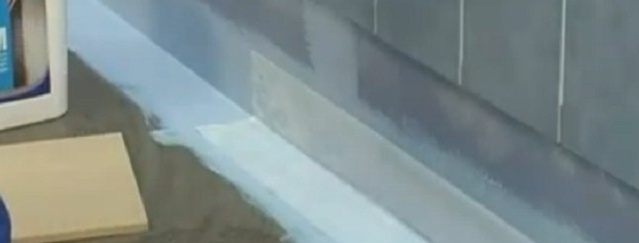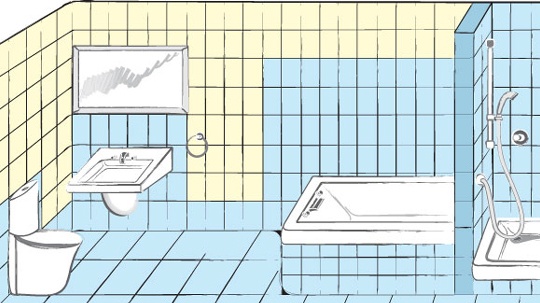How to waterproof in the bathroom?
Waterproofing is the application of materials that do not allow water to pass onto the surface of the floor and walls. This type of repair is being done at the location of the bathrooms, to prevent the occurrence of fungi, mold and other "joys" of the damp room. The expediency of waterproofing does not require discussion, because if it is not fulfilled, then evaporation and condensate penetrate even under the tiles laid in the bathroom over time, causing all of the above consequences, negative both for the appearance of the room and for the health of their owners. A separate point is the increase in the service life of finishing materials in the bathroom, as well as minimizing possible misunderstandings with neighbors due to an open tap, a burst pipe or other accidents ...
Where waterproofing is needed first of all?
Before performing work, the first thing to do is determine what type of materials to use. They are mainly divided into two types. The first is covered with plastering, the second - glued.
Lubricants
Liquid or doughy masses applied with a roller or spatula to an insulated surface. It takes some time to harden. The positive aspects, of course, are the possibility of using them on uneven surfaces, excellent adhesion to the surface, and relative ease of work. The disadvantage is that most of the coating materials will last long enough if you additionally make a filler screed on them.
For coating works on waterproofing, ordinary bitumen remains the most inexpensive option. However, consider its short service life (3-5 years), as well as the need to heat it before applying to the surface to be treated to a temperature of 120 ° C.
If necessary, save, you can also use special varnishes. They are applied in several layers and are a good protection against moisture. However, the drawback is the same as that of bitumen - fragility. After 5-6 years, the waterproofing will need to be redone.
A much better, albeit more expensive, option would be to use more modern bitumen-based materials. This is bitumen-rubber or bitumen-polymer mastic. They are much more reliable, durable, and not capricious to the conditions of work, up to subzero temperatures.
The highest price and appropriate quality are cement-polymer mastics. They look great on molten plasticine. When processing surfaces, they remarkably leak into the smallest slots, filling holes and forming a reliable coupling, and the content of polymers, silicone or acrylic dispersions in the base, guarantee the durability and effectiveness of these materials.
If hiring craftsmen is not the best way for you, and you have done waterproofing your bathroom with your own hands, then do not forget that there is no single recipe for using coating mixtures, and carefully study the instructions for use. Also stock up on the necessary tool. Liquid mastics are applied with a roller or brush, and thick mastics with a trowel or putty knife. If thick mastic is used, then stock up with a wide spatula to even out the surface.
Processing begins from an angle, or from a joint of seams. It is desirable to process all surfaces, but even if only the floor is processed, it is still necessary to "climb" 20-30 cm onto the walls. Do not forget about the pipes - they should be worn with gaskets and also coated with mastic.
Wormy materials
This is essentially the same bitumen reinforced with polyester or fiberglass. Depending on the cost of such waterproofing, there are materials containing polymers and other additives. According to the method of application, they are divided into self-adhesive and guided.The first ones act like ordinary stickers, the protective film is removed, and the roll itself is rolled on the surface to be treated. The guided ones are mounted using a gas burner. The roll is laid out on the surface, heat treated, then rolled out with a heavy roller.
The biggest advantage of pasting is undeniable profitability - not a single coating mixture will cost you as cheap as a few rolls of ready-made waterproofing. An additional advantage is the speed of installation, plus the absence of the need to wait until the treated surface is ready to take on the next stage of repair work.
The negative aspects include, first of all, the unpleasant and persistent smell of bitumen itself. Equally important is the need for thorough surface preparation - for laying rolls a perfectly flat and dry base is required. It should also be remembered that inaccuracies in performance can nullify all the effort expended, so the gluing of waterproofing panels should be done with extreme accuracy.
The main stages of waterproofing
First of all, it is necessary to carry out preparatory work. These include:
- Surface preparation. It is necessary to thoroughly clean the processed base from debris and dust. If the height difference is more than 2 mm, it is necessary to make a leveling screed.
- If concrete, plaster is insulated, as well as when using cement screed, the surface must be moistened. This is done due to the porous structure of these materials in order to avoid premature drying of the solution.
- Primer base. This is a mandatory procedure, which at times improves the quality of adhesion of waterproofing to the treated surface.
- Sizing of moisture-tight joints with reinforcing tape. Pay attention to the gaps between the walls and the floor, between the floor and the plumbing, etc.
After completing all the above preparatory work, proceed directly to the application of waterproofing, according to the recommendations for the particular material used.




